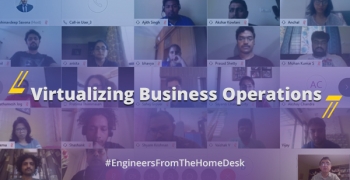Enterprises today face a common challenge: to create effective talent pools that can lead the organization to new levels of success. The skill pool, available globally for enterprises to build their resource ecosystems, is more or less of the same quality. The top of the pyramid consists of visionary innovators, while the mid layer comprises ambitious executors, and the bottom layer comprises diligent doers. Leadership may not necessarily mean managing top-down but in this new age, managing from the center.
A leadership quotient is not just a function of IQ and EQ, but also XQ — XQ being the gut instinct - https://leadershipdesigngroup.com/leadership-quotient-design/
While it is critical for a leader to be seen at the forefront, it is also important for him or her to understand the team dynamics and manage individuals and aspirations in the right manner. That means he or she needs to be part of it.
A leader’s role is, therefore, changing from the age-old top-down style to “managing from the center.” Essential qualities for any leader today are to lead by example, create value for the team, and channelize energy and ideas to a common fulcrum. This is possible only when the leader has worked with the team to define a common objective and has then chalked out a strategy to achieve that shared goal. What this translates into is working with the team and being part of it. Of course, it remains true that a leader doesn’t need to be a subject expert. In fact, he/she perhaps shouldn’t be one but rather focus on surrounding himself with those. Essentially, the leader needs to sit at the center pulling the strings together.
A leader today needs to be an energy manager: managing the energies above, below, and around to align together the top-performing alphas along with others in the team and bring them to a central focal point of shared vision, goal, and outcome. There is also room for innovation once a common value system has been created, for example, through reverse mentoring where millennials mentor older colleagues to pick up new-age tech skills which are high in demand.
Being a leader in the contemporary digitally agile world is an altogether different concept than what it meant in the past. Organizations today are beset by a number of challenges on the HR front. Teams of diverse backgrounds, often based in remote locations, need to work together. So, leaders have to necessarily manage multi-generational and multi-geographical workforces. It is, thus, imperative that the contemporary leader needs to have a GRIP on the four critical aspects of teaming – goals and mission, roles, interpersonal relationships, and processes.
We are living in times of exploration with so much unknown around us. It is essential that leaders are part of the explorative journeys on which they send their teams. A leader needs to explore the new technical world himself/ herself; if he/she doesn’t ask “What’s new?” and “What’s out there?” he/she would never learn this from just being told or receiving reports. That’s where leading from the center gets tangible.
Organizations, thus, have to find a way to glue the different elements together by fostering effective team-centric leadership. It becomes important for high-performing sustainable teams to have a common value system for the enterprise. This is even more important for a leader to understand, because irrespective of how good a leader’s vision is, there always will exist outliers with differing views and objectives within an organization.
The only way to streamline and align divergent views with the common goals is for a leader to establish a shared vision and create a value system for the entire team. Once this is done, the rollover effect of this vision gains a critical mass and drives a momentum that creates coherence with the individuals and situations and enables even the moderate outliers to align with the common goal. Teaming, therefore, becomes a powerful concept, especially with millennials and a true leader will motivate the team by creating a platform for collaboration.
To sum it up, a leader can be likened to the conductor of an orchestra. There will be different instruments of various sizes and shapes. The tune of a harp is as important in a symphony as the note of a violin. Communication and transparency bind it all together, but characteristics that are almost more important are awareness and focus. A blink-of-an-eye slippage can lead to great disharmony in a concert. In an orchestra, all players understand their roles and play to a common tune. Only sitting amongst the musicians makes one hear the different tones and sounds. All the performers, regardless of varying levels of skill, come together and collectively take a bow for the performance. Organizational leadership is no different and organizational dynamics, too, are no different!
Leadership is a Journey Not a Destination!





